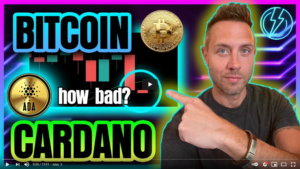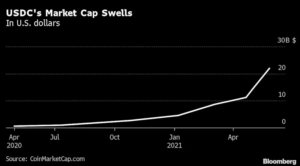Can slow and steady win the crypto race?
Growing concerns over Bitcoin’s sizable carbon footprint have put green cryptocurrencies into the spotlight. None more so than Cardano (ADA). At the time of this writing, Cardano is the fifth biggest cryptocurrency by market capitalization, and CoinMarketCap says its native token, ADA, is worth about $1.80.
But sustainability is only one of the interesting things about Cardano.
Cardano’s founder and CEO Charles Hoskinson is also passionate about economic accessibility because there are billions of people in the world who can’t open bank accounts or access affordable credit. Hoskinson is aiming to solve that.
What is Cardano?
The breadth of what Cardano is trying to achieve makes it difficult to sum up in a few sentences. Hoskinson calls it the “Swiss army knife of protocols” that solve real problems.
Think of Cardano as a platform where people can build applications that address a whole host of issues. From preventing counterfeit medicine to enabling access to microfinance, the Cardano network opens the way for people to use blockchain technology to improve the world we live in.
Unlike Bitcoin and Ethereum, Cardano uses the proof of stake (PoS) model to mine new blocks in the chain and verify transactions. Only a fraction of the people who own Cardano can mine ADA, which dramatically reduces its energy consumption. By contrast, Bitcoin’s proof of work (PoW) model puts no restrictions on the number of computers that can mine. So as a currency like Bitcoin becomes more valuable, more companies invest more computing power into mining it.
How Cardano can help to manage value
In a recent interview with Real Vision Finance, Hoskinson says Cardano is, “A collection of protocols and technology that allows you to transform, store, and manage value, identity, and governance.”
OK, but what does that actually mean?
Basically, you can store any asset on Cardano (like stocks, money, or NFTs) and build in smart contracts to manage them. Smart contracts are a hallmark of cryptocurrency — small pieces of code that can automatically execute terms of an agreement without human involvement. At a very simple level: I’ll pay you 5 ADA if you mow my lawn.
How Cardano can help to manage identity
Identity is another important aspect to Hoskinson. Your identity underpins your credit score and your access to products like bank accounts and personal loans. Just as people can use services like Experian Boost and UltraFICO™ to get rent and utility payments counted toward a credit score, blockchain technology can also be used to establish identity and creditworthiness in the developing world.
For example, in April, Cardano announced a partnership with the Ethiopian Ministry of Education. Cardano’s technology will be used to create tamper-proof records for 5 million students and teachers. Not only will it give them an identity, it will give them a verifiable record of their academic achievements that can help them enter universities abroad and qualify for jobs.
Cardano pros and cons
| Benefits | Risks |
|---|---|
| Reputable team | Early days |
| Environmentally friendly | Ambitious scope of work |
| Peer-reviewed technology | Not memeable |
| Scalable | Competitors in same space |
| Substance over hype | No first-mover advantage |
Cardano’s technical and human credentials are some of its biggest strengths. Hoskinson was one of the co-founders of Ethereum and has been involved in crypto since the beginning. That experience allows him to anticipate potential problems and build in solutions.
For example, some digital currencies may run out of cash once they use up the funds from their initial coin offering. But Cardano has built a treasury system into the platform. A small percentage of each transaction goes toward ongoing development of the coin.
Cardano’s approach differs from other currencies. Each stage of its development has been peer-reviewed. Rather than putting a product on the market, and updating it on the fly, Cardano first tests each step before putting weight on it.
On the other hand, it’s early days for Cardano. In all the crypto hype, it’s the memeable coins (like Doge) with celebrity endorsements that are getting the lion’s share of the attention. That said, Cardano does have a loyal following — Hoskinson says there are almost a million people in the community.
There’s still a lot of work to be done, however. Cardano may have a much more solid technical base, but it also missed the first-mover advantage. Ethereum needs an upgrade to solve its sustainability and scalability issues. But it already hosts thousands of alt coins and applications and has been running smart contracts for some time. Cardano is only just ready to launch them.
Only time will tell whether Cardano’s slow-and-steady approach will win out.
Should you buy Cardano?
All cryptocurrencies are highly volatile and speculative investments. Cardano has a strong team behind it and has already achieved a lot — the project in Ethiopia is an impressive real-world use of blockchain technology.
Ultimately, everybody has a different financial situation, risk tolerance, and investment strategy. As we’ve seen, Cardano is smaller and younger than Bitcoin, which brings both advantages and risks. What’s important is to understand what those are and weigh them against your own needs. Only invest money you can afford to lose, and try to balance out the risky nature of crypto investment by building a diversified portfolio.
——————————————————
Originally Published On: The Ascent
Photo courtesy of: The Asecnt
Follow Crypto News Now on Twitter: www.Twitter.com/CryptoNewsNow
Like Us On Facebook: www.Facebook.com/CryptoNewsNow



